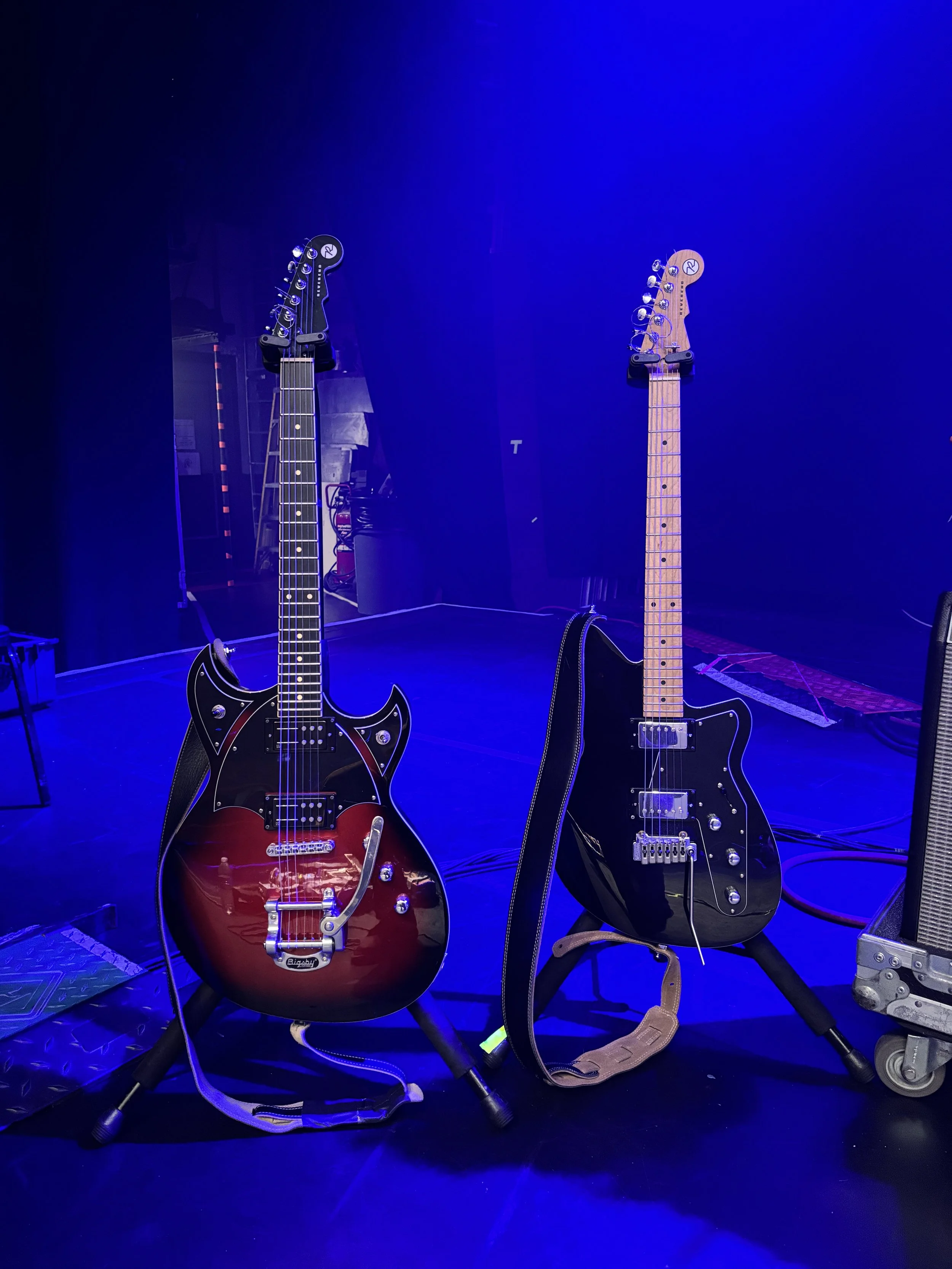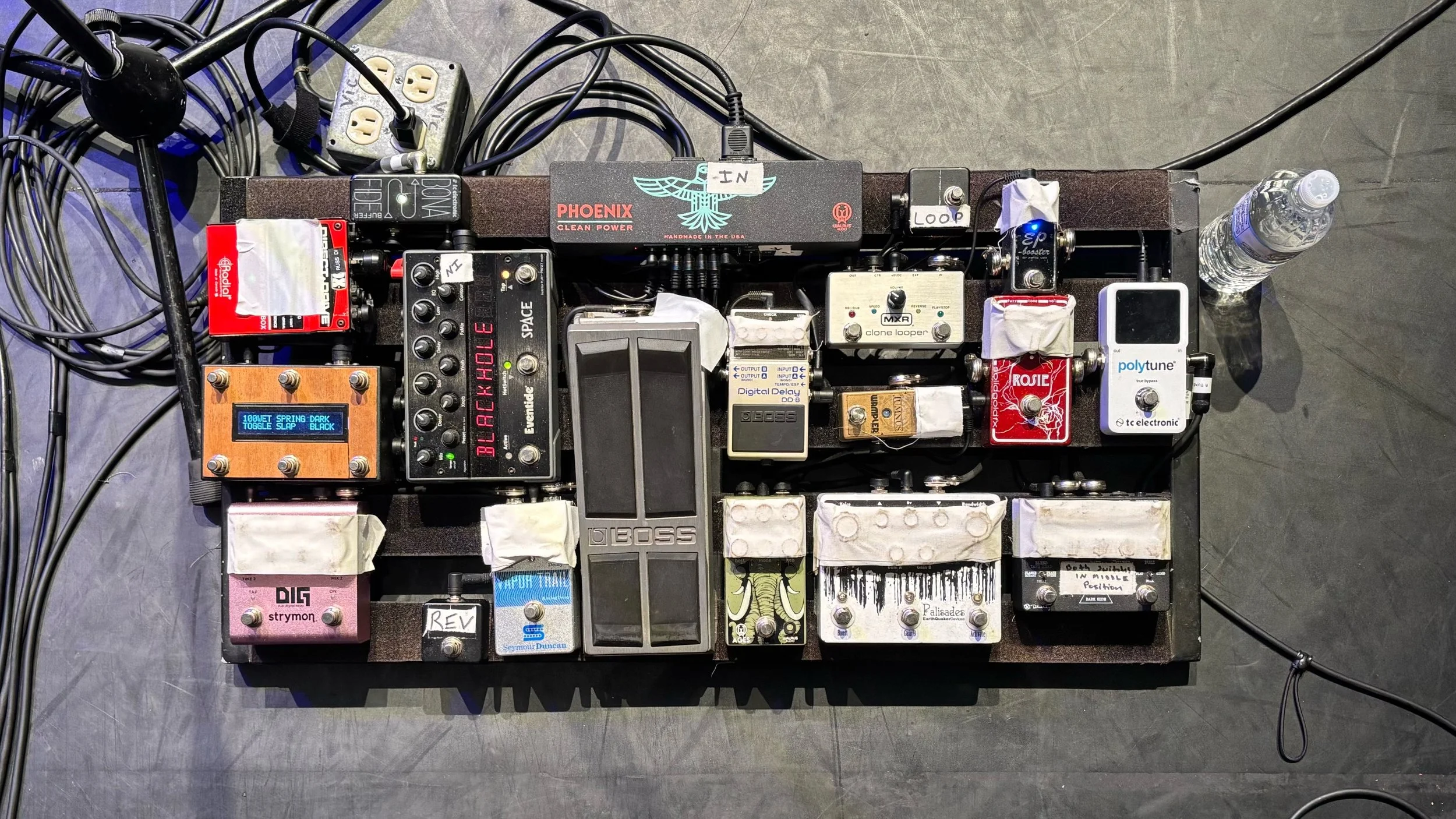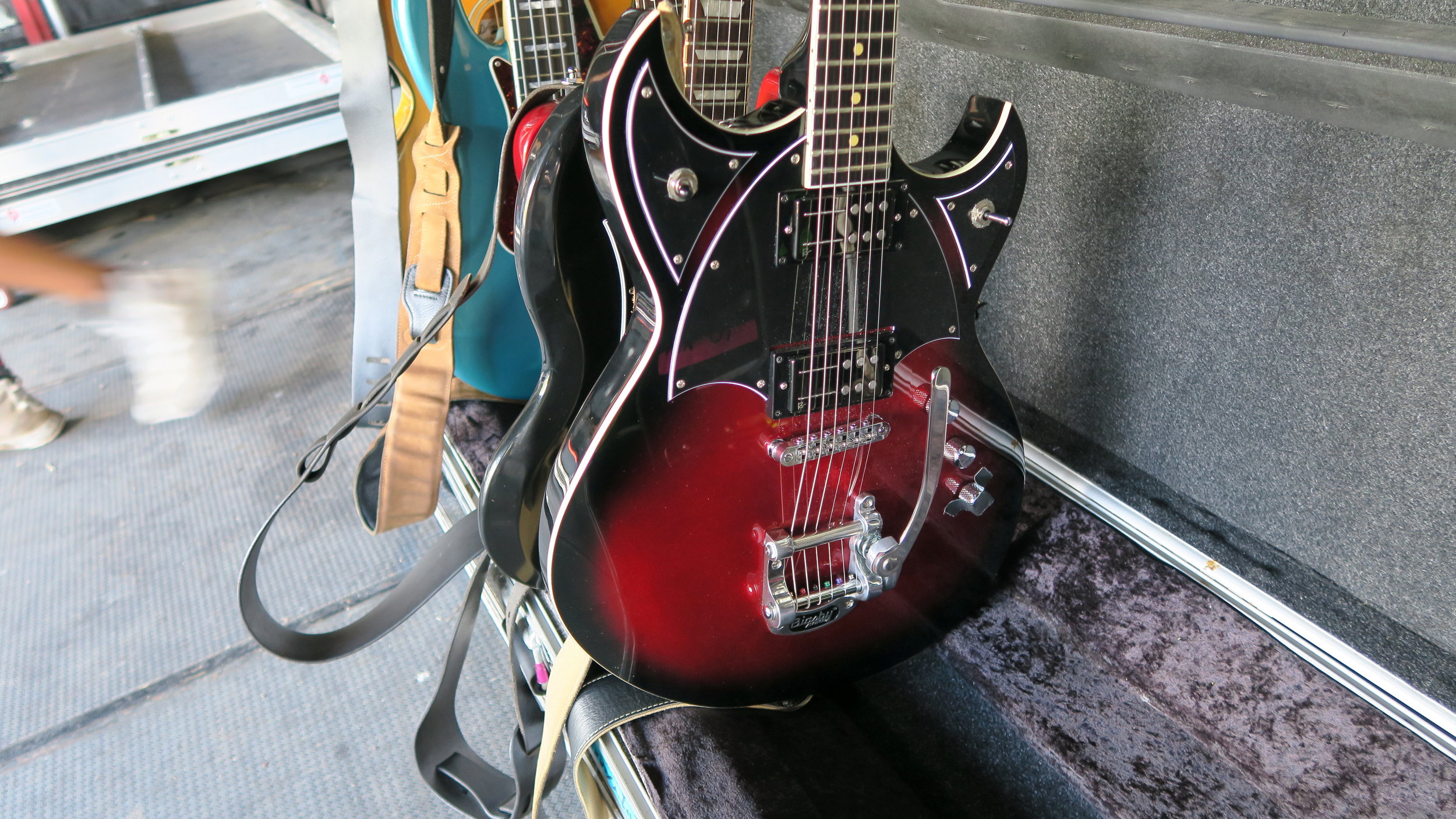I'm sitting in a [surprisingly nice] hotel in East Lansing, Michigan on an offday between shows in Chicago and Toronto. We're now halfway through the VHS(X) tour and I thought it would be an excellent time to write up a little rundown of the gear I'm using on this run. I'd love to tell you, dear reader, that I plan to post write-ups like this one more regularly but the reality is that it's likely to be another few years before I get around to the next one; I'm terrible with staying on top of these things.
I currently have two guitars on the road with me; both of them are made by Reverend and both are solid as a rock. I own quite a few guitars at this point in my life but the solid construction and stability of Reverend's instruments makes them a no-brainer for touring. Give me a guitar that feels inspiring to play right off the shelf and can be flown around the world without needing a neck adjustment over something flashy and/or collectable. The Reverends I own are very literally the only guitars in my collection that I haven't modified; those instruments remain totally stock because the good people at Reverend have built guitars with the accoutrements that players are looking for already installed. The Reeves Gabrels signature model I use, the Spacehawk, is a guitar that I've been playing with XA for many years now; if you'd like more info on it I suggest you check out my previous post on this page. It's such a beefy sounding guitar; I love how the chambered body encourages musical feedback and the Railhammer pickups have a fat frequency response that I feel really lends itself to soaring single-note playing. The other guitar is a Reverend Jetstream HB, a newer acquisition. Unlike the Spacehawk, which is 24.75" scale, the Jetstream is 25.5". I find it to be a little brighter, presumably the result of the longer scale length and the voicing of the PAF-inspired, HA5 pickups. I love the reliability of the Wilkinson WVS50 IIk vibrato system on that guitar; it's almost Floyd Rose level stability. Both guitars live in standard tuning and are strung with standard D'Addario XL 10-46 nickel wound strings; I love them and they're industry standard for a reason.
Truthfully, it's pretty arbitrary what guitar I use for what song during the set; both guitars live on gravity stands next to me and I pick up whichever I feel inspired to play at any given moment. The exceptions are during 'Low Life' and 'Follow The Sound Of My Voice', when I always use the Spacehawk. I find the soft action of the Bigsby on the Spacehawk more effective for performing the gentle vibrato moves that pervade 'Low Life' and the drop-D tuning 'Follow The Sound Of My Voice' calls for more easily achievable with the Spacehawk. I run both guitars full-open throughout the set with the exception of 'Boom', when I'll roll off some low-end via the on-board high-pass filter during the featured line. In general, with either guitar, I'm leaning on the neck pickup the majority of the time. I'll use the bridge pickup only during a few solos when I feel like I need a little extra help cutting through a dense mix. It's extremely rare that I use both neck and bridge pickups together on these guitars.
While several of the pedals you see on this board are pedals that I've been using live for many years, the board is something that I put together specifically for this tour. My signal chain is as follows...
TC Electronics PolyTune (1st Generation)
Keeley Dark Side
SolidGoldFX Rosie
Xotic USA EP Booster
Earthquaker Palisades
Walrus Ages
Wampler Tumnus
MXR Clone Looper
Boss DD-8
Boss FV-500H
Seymour Duncan Vapor Trails
Strymon DIG
Eventide Space; controlled via Morningstar MC6
Radial JDX; 'Output' to FOH, 'Thu' to amp
TC Electronics Bonafide Buffer
The Radial JDX is always on a Twin setting; an effected signal goes direct to front of house and an uneffected signal runs to the TC buffer before continuing on to the amp. I love the simplicity, reliability and minimalism of the JDX unit; it's such a tank! For the 'Townie' tour Sam and I each added a JDX to our boards. This was initially done as a failsafe measure but since then, Zach Jurkovich, our front of house engineer, has actually opted to make use of a blend of the live amps and the JDX lines in the mains. That said, all I'm hearing in my in-ears on stage is my live amp. I found hearing any of the JDX had the potential of presenting phase issues and the lack of 'sag'/inherent compression in the JDX sound made for a less than desirable monitoring experience. It's Zach's discretion how he chooses to use my two lines.
My leads on either side of the board are 15"; I don't like going any longer than that with unbalanced cables. I like to avoid high end degradation that can occur with an increase in capacitance. The amp I'm currently using is my old Fender Twin ('65 Reissue); it's completely stock, outside of the occasional tube replacement. For this tour we've been leaving the amps on the road case casters. The amp is miked with a standard 57 right at the edge of the dust cap, almost touching the grill cloth. My settings are written on the white gaff tape on the top of the amp. I'm always running into the 'vibrato' channel.
Many of the pedals I'm touring with are the actual pedals I used while recording VHS(X); those include the EP Booster, Tumnus, Rosie, Palisades, DIG and DD-8. The remaining pedals on the board are mostly there to emulate driven amp sounds or in-the-box processing we utilized during the recording process. This is especially true for the Space, which I've programmed to channel many of the reverbs I dialed in with Valhalla Plate and Valhalla Super Massive.
The EP Booster is working as an 'always-on' preamp of sorts. I'm almost always running a preamp pedal, no matter what the situation, but I find it's especially critical when playing through a high wattage amp, like a Twin; in my opinion it's critical to push the front-end of an amp like that to encourage some sag and introduce some compression. When playing Gibsons I'm most typically using a Klon-style pedal (usually a Walrus Voyager, one of my personal favorites) but with these Reverend guitars I find I prefer the additional low end that the EP Booster provides.
All the pedals on the board are powered by the ever-so-reliable Walrus Phoenix.
The DIG delay is always set to a dotted-eighth note; I tap in the tempo of each song manually. The DD-8 is only used for the reverse function; I've added a remote switch for tap tempo.
Here's a brief synopsis of my pedal moves for the VHS(X) songs we're performing...
Jungle - Fuzz side of the Dark Star throughout; Ages layered on-top for intro; DIG delay added for instrumental bridge and solo
Loveless - First stage of Palisades throughout; Blackhole algorithm on Space added during final moments of the song
Hang On - DIG delay during intro; bass thereafter
Low Life - Vapor Trails for slapback throughout; DIG delay and first stage of Palisades layered on-top for choruses and solo
Fear - No effects for verses; first stage of Palisades for choruses and instrumental bridge
Nervous - Bass; no effects
Feather - Acoustic guitar; no effects
Superpower - Rosie throughout
Naked - First stage of Palisades, DIG delay and Blackhole algorithm of Space throughout
Gorgeous - Dark Side tape delay, reverse delay via DD-8 and Clone Looper improvisation throughout running into DIG delay and Blackhole algorithm; Rosie added for final chorus and solo
Unsteady - First stage of Palisades, DIG delay and Blackhole algorithm of Space throughout; second stage of Palisades added for solo
Renegades - Vapor Trails for slapback throughout; first stage of Palisades, DIG and Blackhole algorithm added during intro, interludes and latter choruses; second stage of Palisades and DD-8 reverse delay engaged for outro solo
Until next time! Straight ahead and strive for tone!








































